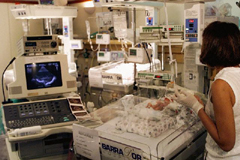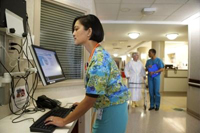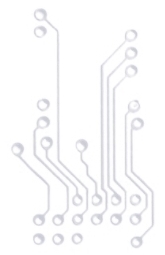 To begin an analysis of nursing informatics related theory, it is logical to examine the concept of antithesis, since this dystopic notion seems to be the primary cause of resistance to information technology within nursing; it highlights the gender issues inherent in this process; and emphasizes the need for nurses to be critically involved in how technology is allowed and assumed within nursing practice (Barnard, 2000). To begin an analysis of nursing informatics related theory, it is logical to examine the concept of antithesis, since this dystopic notion seems to be the primary cause of resistance to information technology within nursing; it highlights the gender issues inherent in this process; and emphasizes the need for nurses to be critically involved in how technology is allowed and assumed within nursing practice (Barnard, 2000).
Dystopic Resistance
Within the literature, a noticeable theme of dystopic resistance prevails, one that highlights the dehumanizing, impersonal, objectifying effects of using information technology within the provision of client health care. Often, the use of technologies are seen as paradigmatically in opposition to humanistic, holistic and client-focused care (Barnard & Sandelowski, 2001). Nurses complain that they spend far too much time interacting with technology in lieu of focusing their attention on their assigned clients (West, 2003). “Recent research on technology and registered nurses' work in acute care surfaces evidence that unchecked technological practices in acute care environments dismember and denature nursing care into assembly line tasks that depart from the healing nature of nursing care” (Marck, 2000, p. 63). Reductionist technology has spawned the development of health related technologies that order, classify, monitor, and record data and information, but miss the point in mirroring the deep and true meaning of a client's experience and recovery, or the richness of the actual nursing care provided. Thus, it seems that the resistance exhibited by nurses is grounded within a moral imperative and conscious decision to put client before machine; to put the need to care before the need to compute. “What determines experiences such as dehumanization is not technology per se but how individual technologies are used and operate in specific user contexts, the meanings that are attributed to them, how individuals or cultural groups define what is human, and the organizational, human, political, and economical technological system (technique) that creates rationale and efficient order within nursing, health care and society” (Barnard & Sandelowski, 2001, p. 367).
 In a phenomenological study with surgical nurses, Barnard (2000) found that “technology to a greater or lesser extent can interfere with a nurse's freedom to determine and accomplish individual goals, professional approaches to care and principles of nursing practice. Technology demands levels of attention, time and commitment that can be arduous for a nurse and inappropriate to the needs of patients and the clinical environment” (p. 1138). Barnard summarized this as an interference “with the will (violition) of nurses and the practice of nursing” (p. 1138). Especially in clinical areas where technologically monitored health procedures are copious, such as post-operative, critical care, and intensive care settings, the machines, monitors, and other technical apparatus can demand as much or even more attention from the nurse as the client in question does. “Machinery and equipment are designed specifically to attract attention. Devices with alarms, lights and buzzers purposefully draw nurses to the technology” (p. 1138). In essence, the nurse's ability to provide the kind of humanistic, client-focused care that is aspired for is perceived as being compromised by the demands of technology in the form of diagnostic, therapeutic, and physiological surveillance machines. “Information technology, as well as technology in general, can be seen as a threat. And we have good reasons for seeing it in this way, particularly where we use it for transforming all other possible forms of human interaction under the premises of this perspective. Within this approach, we see the originality of the perspective as the only possible one” (Capurro, 1992, p. 7). In a phenomenological study with surgical nurses, Barnard (2000) found that “technology to a greater or lesser extent can interfere with a nurse's freedom to determine and accomplish individual goals, professional approaches to care and principles of nursing practice. Technology demands levels of attention, time and commitment that can be arduous for a nurse and inappropriate to the needs of patients and the clinical environment” (p. 1138). Barnard summarized this as an interference “with the will (violition) of nurses and the practice of nursing” (p. 1138). Especially in clinical areas where technologically monitored health procedures are copious, such as post-operative, critical care, and intensive care settings, the machines, monitors, and other technical apparatus can demand as much or even more attention from the nurse as the client in question does. “Machinery and equipment are designed specifically to attract attention. Devices with alarms, lights and buzzers purposefully draw nurses to the technology” (p. 1138). In essence, the nurse's ability to provide the kind of humanistic, client-focused care that is aspired for is perceived as being compromised by the demands of technology in the form of diagnostic, therapeutic, and physiological surveillance machines. “Information technology, as well as technology in general, can be seen as a threat. And we have good reasons for seeing it in this way, particularly where we use it for transforming all other possible forms of human interaction under the premises of this perspective. Within this approach, we see the originality of the perspective as the only possible one” (Capurro, 1992, p. 7).
 This perception is strongly associated with resistance in nurses towards informational technology as well as less sophisticated technologies within the clinical milieu. This resistance has multiple layers: technology is seen as a distractor that takes away from time, energy, and interaction that could be spent with the client. Technology is also often seen as an imposed directive that comes from on high – an unnegotiated result of administrative decisions that did not involve the nurses themselves, yet relies on their participation for successful implementation. “According to studies conducted at Clarian Health System during the mid 1990s, nurses provide less than one hour of direct care to their patients in a 12 hour period. The remaining time is spent managing and coordinating communication to other departments, physicians, or members of the healthcare team” (Bartholomew & Curtis, 2004, p. 5). This perception is strongly associated with resistance in nurses towards informational technology as well as less sophisticated technologies within the clinical milieu. This resistance has multiple layers: technology is seen as a distractor that takes away from time, energy, and interaction that could be spent with the client. Technology is also often seen as an imposed directive that comes from on high – an unnegotiated result of administrative decisions that did not involve the nurses themselves, yet relies on their participation for successful implementation. “According to studies conducted at Clarian Health System during the mid 1990s, nurses provide less than one hour of direct care to their patients in a 12 hour period. The remaining time is spent managing and coordinating communication to other departments, physicians, or members of the healthcare team” (Bartholomew & Curtis, 2004, p. 5).
Timmons (2003) studied the resistance exhibited by acute care nurses towards the implementation of information technology in the workplace. “The theoretical basis for this study is the social construction of technology. This is the idea that machines have meaning and in fact, they can have different meanings for different groups of people. This is interpretative flexibility of machines. For instance a care planning system could variously be interpreted as being symbolic of an up-to-date, high-tech profession, as a way of improving the care of patients, and as a bureaucratic imposition. The flexibly interpreted nature of technology influences its development” (p. 261).
 Timmons considered Dowling's (1980) model of resistance which consisted of five unique resistance categories, but with some qualification. “Dowling (1980) delineates five types of resistance: a) passive resistance (failure to cooperate) b) oral defamation c) alleged inability to operate the system d) data sabotage and e) refusal to use. The real weakness of Dowling's work is that it makes no attempt to situate these phenomena in a wider context, and he suggests standard managerial responses such as improved training and communication without giving much detail about what forms they might take. As well, resistance is a more complex, multilayered phenomenon than these analyses might suggest” (Timmons, 2003, p. 259). The nurses studied by Timmons primarily demonstrated resistance by either delaying their personal participation in the training sessions and actual utility of the new technologies or engaging in criticism of the systems. “Resistance was as much about the ideas and ways of working that the systems embodied as it was about the actual technology being used. The patterns of resistance can best be summed up by the phrase “resistive compliance” (p. 257). Timmons considered Dowling's (1980) model of resistance which consisted of five unique resistance categories, but with some qualification. “Dowling (1980) delineates five types of resistance: a) passive resistance (failure to cooperate) b) oral defamation c) alleged inability to operate the system d) data sabotage and e) refusal to use. The real weakness of Dowling's work is that it makes no attempt to situate these phenomena in a wider context, and he suggests standard managerial responses such as improved training and communication without giving much detail about what forms they might take. As well, resistance is a more complex, multilayered phenomenon than these analyses might suggest” (Timmons, 2003, p. 259). The nurses studied by Timmons primarily demonstrated resistance by either delaying their personal participation in the training sessions and actual utility of the new technologies or engaging in criticism of the systems. “Resistance was as much about the ideas and ways of working that the systems embodied as it was about the actual technology being used. The patterns of resistance can best be summed up by the phrase “resistive compliance” (p. 257).
Criticisms of the technology usually center around three primary concerns: a) Criticisms of the actual system such as time consumption, inconvenient access, glitches, volume of data; b) Security issues and c) Nursing issues, such as the notion that technology distracts nurses from providing quality individualized client care. When allowed the opportunity to voice their genuine perceptions of new technologies, nurses tended to be forthright and open about the perceived faults of the currently used information systems within the work milieu. “Nurses are knowledgable reflexive actors who can give meaningful accounts of their actions in this context and the reasons for them” (Timmons, 2003, p. 260). Although it might seem like nurses had little power in the implementation of information systems in hospitals and other health care environments, their own resistance represented a presupposed power, one that is grounded in the advocacy, protection and primary obligation to ensure that high quality client care is provided.
 Another factor that contributes strongly to resistance is the notion of generational cohort and technological confidence. “We're well aware that the average nurse is 44 years old. This directly impacts technology usage: Older nurses have long-established practice patterns and habits and may often view new technologies as a distraction, something that takes their attention away from the patient. One expert reports that nursing resistance alone has caused the death of numerous IT initiatives. Ironically, while we demand new technology, we actively resist it” (Bartholomew & Curtis, 2004, p. 5). Another factor that contributes strongly to resistance is the notion of generational cohort and technological confidence. “We're well aware that the average nurse is 44 years old. This directly impacts technology usage: Older nurses have long-established practice patterns and habits and may often view new technologies as a distraction, something that takes their attention away from the patient. One expert reports that nursing resistance alone has caused the death of numerous IT initiatives. Ironically, while we demand new technology, we actively resist it” (Bartholomew & Curtis, 2004, p. 5).
The literature supports the notion that the average middle-aged nurse has used manual methods of data and information recording and processing for most of their working life, and often resist changing to electronic documentation since it disrupts the comfortable process that has become part of their socialized roles. “Cultural and societal factors may play a larger role in nurses' willingness to embrace the CIS than attitudes toward computers themselves. Resistance has less to do with specific functionality of the technology – screen design or the mouse, for example – than with cultural factors such as lack of time and loyalty to the historic model of paper documentation” (Kirkley & Stein, 2004, p. 216).
Although this idea that generational cohort determines comfort with technology is common across many disciplines, there are always exceptions to the common rule. Perhaps the noticeable difference between nurses born within the “Baby Boomers” generation compared with the new graduates who belong to the “Generation X” or “Millennials” age cohort is a simple reflection of the mismatch between information technology design/interface and the actual needs of nurses and their clients. “Nurses do not resist technology itself. What they resist is the addition of one more item to their workday. A significant point of resistance may come down to the nurses' fear that online charting will take more time than paper charting. The most common criticism from nurses about CIS was that the systems were time consuming” (Kirkley & Stein, 2004, p. 217). Other criticisms focus on the imposition onto nursing (female dominated, thus feminine) from the masculine domains of medicine and technology.
A Question of Gender
 Nursing has been a female-dominated profession throughout its entire history : even today less than 5 per cent of nurses are male. This fact has understandably influenced the investigation of how visible nursing presence, knowledge, ideas, and theories are within the landscape of health care, including the adoption and implementation of health information systems. Often, the high female ratio in nursing has been used as an excuse to justify the exclusion of nurses from decision-making, planning, and even the adoption process in implementing information systems, yet they are expected to fulfill the goals of the implementation plan by exercising compliance and ability. “Nurses drew from ideological or referent systems that linked female/nurse to nature, nurturance, and caring, and technology to male/power and control over nature, to position nursing as female culture at odds with masculine technology. Depicted as a force for the dehumanization of both patients and nurses, technology signified Other to and even enemy of nursing. This stance reinforces gender distinctions that have traditionally worked against nursing. It also reinforces the prevailing cultural view of women as antitech, technophobic, and unskilled” (Sandelowski, 1999, p. 202). Sandelowski also pointed out that it is usually nurses who educate, enlist, conjole, and elicit compliance from clients to work with health technologies without resistance. She also describes how nurses have been linked with technology since the beginning of hospital-based health care, and are often depended on to exercise the mundane tasks associated with keeping the information system functioning as well as ensuring that all administratively or medically prescribed technological activities are completed and complied with. Nursing has been a female-dominated profession throughout its entire history : even today less than 5 per cent of nurses are male. This fact has understandably influenced the investigation of how visible nursing presence, knowledge, ideas, and theories are within the landscape of health care, including the adoption and implementation of health information systems. Often, the high female ratio in nursing has been used as an excuse to justify the exclusion of nurses from decision-making, planning, and even the adoption process in implementing information systems, yet they are expected to fulfill the goals of the implementation plan by exercising compliance and ability. “Nurses drew from ideological or referent systems that linked female/nurse to nature, nurturance, and caring, and technology to male/power and control over nature, to position nursing as female culture at odds with masculine technology. Depicted as a force for the dehumanization of both patients and nurses, technology signified Other to and even enemy of nursing. This stance reinforces gender distinctions that have traditionally worked against nursing. It also reinforces the prevailing cultural view of women as antitech, technophobic, and unskilled” (Sandelowski, 1999, p. 202). Sandelowski also pointed out that it is usually nurses who educate, enlist, conjole, and elicit compliance from clients to work with health technologies without resistance. She also describes how nurses have been linked with technology since the beginning of hospital-based health care, and are often depended on to exercise the mundane tasks associated with keeping the information system functioning as well as ensuring that all administratively or medically prescribed technological activities are completed and complied with.
It is a given that gender-related issues are a critical factor in the knowledgeable application of information technology to nursing, especially historically, yet it does not seem to be the essential reason. Resistance to change is common place in any organizational setting, including health care ones. Yet, the critical force that appears to be the biggest source of resistance is the sense that the use of technology prevents nurses from caring for their clients in the way that they morally, ethically, and professionally know they must. “For many, technology is still something nurses must work with, work around, or work hard to make compatible with, or supportive of nursing care. To this end, we have encouraged each other to develop an ethical awareness, in order to temper the effects of technology” (Barnard & Sandelowski, 2001, p. 368). Nurses need to be involved in the development of information systems that are used in their daily practice. Only they know what will actually work in the health care setting, in the provision of holistic, professional nursing care.
Nurses Shaping Technology
 Despite the promise and growing evidence that the use of information technologies in health care promotes efficiency and productivity and reduces redundancy of effort, resistance towards the use of technology in health care is still an important issue. “Many health care professionals regard computing as a world far removed from the concerns that occupy them, a case of the mechanistic versus the humanistic. One factor, however, conjoins the mechanistic and humanistic worlds: information.” (Jones, 1996, p. 591). However, to actually access this information bilaterally, nurses need to have a voice in the design of the systems they use in practice. “Current technology favours a reductionist approach, meaning that nurses could be dictated to by the needs of technology rather than the information needs of their professional practice. Being constricted by reductionist technology may necessitate nurses inputting information that has limited professional value and which fails to capture the richness of patient care and nursing professionalism” (Chambers, 2002, p. 103). Despite the promise and growing evidence that the use of information technologies in health care promotes efficiency and productivity and reduces redundancy of effort, resistance towards the use of technology in health care is still an important issue. “Many health care professionals regard computing as a world far removed from the concerns that occupy them, a case of the mechanistic versus the humanistic. One factor, however, conjoins the mechanistic and humanistic worlds: information.” (Jones, 1996, p. 591). However, to actually access this information bilaterally, nurses need to have a voice in the design of the systems they use in practice. “Current technology favours a reductionist approach, meaning that nurses could be dictated to by the needs of technology rather than the information needs of their professional practice. Being constricted by reductionist technology may necessitate nurses inputting information that has limited professional value and which fails to capture the richness of patient care and nursing professionalism” (Chambers, 2002, p. 103).
Since the beginning of the profession, nurses have applied their ingenuity, resourcefulness, and professional awareness of what works to adapt technology and objects to support nursing care, usually with the intent to promote efficiency but also client comfort and healing. This resourcefulness could also be applied effectively to the adaptation of information technology within the care environment, to ensure that the technology truly does serve both clients and nurses, as well as the rest of the interdisciplinary team. “Part of the problem is that the technology that health care is presently using was not designed to support nurses in the care of patients, more effort needs to be made to change how these data are being collected and accessed. This change should focus on the nurse's need to collect and retrieve data as quickly and easily as possible. It also should foster communication among the members of the health-care team, not hinder it” (West, 2003, p. 31).
 At this point in time it is understandably difficult to involve all nurses in the development and design of health information systems, mainly because few feel confident in their ability to diagnose, experiment, and even visualize what an appropriate system would look and act like. “The lessons of restoration suggest that to counter the technological practices that presently plague many acute care environments, nurses need to develop an ecological literacy that first reinterprets and then reconstructs our relations with a technological world” (Marck, 2000, p. 63). In the future, this simple enough task will likely be easier to negotiate, since nurses who grew up while the Internet, hand-held devices and other technologies were taking hold may feel more attuned to the way technology works. A middle ground can be attained by teaming nurses with designers to brainstorm the best strategies for development, rather than expecting nurses to serve as both user and designer. This can be summed up simply by considering Kirkley and Stein's (2004) advice to “....provide the right functionality and hardware at the right place at the right time. Create functionality that realistically supports and enhances a nurse's work flow, opens channels of communication, and unlocks doors to useful information as a top priority. A well-designed intuitive interface that 'thinks like a nurse thinks' is key” (p. 220). At this point in time it is understandably difficult to involve all nurses in the development and design of health information systems, mainly because few feel confident in their ability to diagnose, experiment, and even visualize what an appropriate system would look and act like. “The lessons of restoration suggest that to counter the technological practices that presently plague many acute care environments, nurses need to develop an ecological literacy that first reinterprets and then reconstructs our relations with a technological world” (Marck, 2000, p. 63). In the future, this simple enough task will likely be easier to negotiate, since nurses who grew up while the Internet, hand-held devices and other technologies were taking hold may feel more attuned to the way technology works. A middle ground can be attained by teaming nurses with designers to brainstorm the best strategies for development, rather than expecting nurses to serve as both user and designer. This can be summed up simply by considering Kirkley and Stein's (2004) advice to “....provide the right functionality and hardware at the right place at the right time. Create functionality that realistically supports and enhances a nurse's work flow, opens channels of communication, and unlocks doors to useful information as a top priority. A well-designed intuitive interface that 'thinks like a nurse thinks' is key” (p. 220).
Thus, the resistance and dystopic view of technology that is found in the nursing and health literature becomes both understandable and worth consideration. More than a mere reaction to imposed change, the resistance evident in nursing practice is actually often founded on a strong moral imperative to safeguard the essentials of client care; to provide open, clear and accurate communication; to ensure that presence and attention is focused on the client rather than the apparatus; and a desire to keep nursing human-focused rather than allowing it to erode into mechanistic action. “Resistance though complex, remains not only analytically useful, but also pragmatically useful, as it is a part of the process by which an 'idealised' system is socially shaped or constructed into a working technology, part of the social fabric area where it is being used” (Timmons, 2003, p. 267).
Just as the dystopic literature in any field warns, the uncritical and unquestioned adoption of technology into any discipline or life area should be resisted. If nurses are to embrace information technology into practice, they must know beyond a shadow of a doubt that they do so to enhance quality client care, from the client's perspective. “In deeply disturbing ways, the speedup of nurses' work mirrors Borgmann's description of “final hyperreality” where a relentless and unreflective absorption of technology as reality predominates. With arguments that support Sandelowski's recent work, Borgmann argues that the underexamined glamour of technology shapes our gaze toward a superficial orientation in daily life, a thinner reality that does not keep more fundamentally moral practices in view” (Marck, 2000, p. 71).
 It is a given that information technology will continue to be integrated and applied to nursing practice and health care in general. It does so in both visible and invisible ways and permeates nursing more and more with each passing year. It is important that nurses gain knowledge of all of the benefits and implications of this techno-saturation, and voice their concerns and visions accordingly. As Barnard and Sandelowski summarized, “We argue for the need for reconciliation of presumed tension(s) between technology and person focused care and the need to reconsider our ways of understanding the relations between technology and nursing” (2001, p. 367). We also need to be fundamentally aware of how information and other technologies shape our way of being in the health care landscape, and how our very profession is being shaped by current electronic developments. “The duality of technology, as matter and meaning, lies not in its necessary opposition to humanization but rather in its recursiveness; in its existence as both objective, material force, and as a socially constructed and chameleon-like entity” (Barnard & Sandelowski, 2001, p. 372). This includes how technology has become a foundational part of organizational and medical culture and by default, viewed as an integral artifact of nursing. It is a given that information technology will continue to be integrated and applied to nursing practice and health care in general. It does so in both visible and invisible ways and permeates nursing more and more with each passing year. It is important that nurses gain knowledge of all of the benefits and implications of this techno-saturation, and voice their concerns and visions accordingly. As Barnard and Sandelowski summarized, “We argue for the need for reconciliation of presumed tension(s) between technology and person focused care and the need to reconsider our ways of understanding the relations between technology and nursing” (2001, p. 367). We also need to be fundamentally aware of how information and other technologies shape our way of being in the health care landscape, and how our very profession is being shaped by current electronic developments. “The duality of technology, as matter and meaning, lies not in its necessary opposition to humanization but rather in its recursiveness; in its existence as both objective, material force, and as a socially constructed and chameleon-like entity” (Barnard & Sandelowski, 2001, p. 372). This includes how technology has become a foundational part of organizational and medical culture and by default, viewed as an integral artifact of nursing.
|




 To begin an analysis of nursing informatics related theory, it is logical to examine the concept of antithesis, since this dystopic notion seems to be the primary cause of resistance to information technology within nursing; it highlights the gender issues inherent in this process; and emphasizes the need for nurses to be critically involved in how technology is allowed and assumed within nursing practice (Barnard, 2000).
To begin an analysis of nursing informatics related theory, it is logical to examine the concept of antithesis, since this dystopic notion seems to be the primary cause of resistance to information technology within nursing; it highlights the gender issues inherent in this process; and emphasizes the need for nurses to be critically involved in how technology is allowed and assumed within nursing practice (Barnard, 2000).  In a phenomenological study with surgical nurses, Barnard (2000) found that “technology to a greater or lesser extent can interfere with a nurse's freedom to determine and accomplish individual goals, professional approaches to care and principles of nursing practice. Technology demands levels of attention, time and commitment that can be arduous for a nurse and inappropriate to the needs of patients and the clinical environment” (p. 1138). Barnard summarized this as an interference “with the will (violition) of nurses and the practice of nursing” (p. 1138). Especially in clinical areas where technologically monitored health procedures are copious, such as post-operative, critical care, and intensive care settings, the machines, monitors, and other technical apparatus can demand as much or even more attention from the nurse as the client in question does. “Machinery and equipment are designed specifically to attract attention. Devices with alarms, lights and buzzers purposefully draw nurses to the technology” (p. 1138). In essence, the nurse's ability to provide the kind of humanistic, client-focused care that is aspired for is perceived as being compromised by the demands of technology in the form of diagnostic, therapeutic, and physiological surveillance machines. “Information technology, as well as technology in general, can be seen as a threat. And we have good reasons for seeing it in this way, particularly where we use it for transforming all other possible forms of human interaction under the premises of this perspective. Within this approach, we see the originality of the perspective as the only possible one” (Capurro, 1992, p. 7).
In a phenomenological study with surgical nurses, Barnard (2000) found that “technology to a greater or lesser extent can interfere with a nurse's freedom to determine and accomplish individual goals, professional approaches to care and principles of nursing practice. Technology demands levels of attention, time and commitment that can be arduous for a nurse and inappropriate to the needs of patients and the clinical environment” (p. 1138). Barnard summarized this as an interference “with the will (violition) of nurses and the practice of nursing” (p. 1138). Especially in clinical areas where technologically monitored health procedures are copious, such as post-operative, critical care, and intensive care settings, the machines, monitors, and other technical apparatus can demand as much or even more attention from the nurse as the client in question does. “Machinery and equipment are designed specifically to attract attention. Devices with alarms, lights and buzzers purposefully draw nurses to the technology” (p. 1138). In essence, the nurse's ability to provide the kind of humanistic, client-focused care that is aspired for is perceived as being compromised by the demands of technology in the form of diagnostic, therapeutic, and physiological surveillance machines. “Information technology, as well as technology in general, can be seen as a threat. And we have good reasons for seeing it in this way, particularly where we use it for transforming all other possible forms of human interaction under the premises of this perspective. Within this approach, we see the originality of the perspective as the only possible one” (Capurro, 1992, p. 7).  This perception is strongly associated with resistance in nurses towards informational technology as well as less sophisticated technologies within the clinical milieu. This resistance has multiple layers: technology is seen as a distractor that takes away from time, energy, and interaction that could be spent with the client. Technology is also often seen as an imposed directive that comes from on high – an unnegotiated result of administrative decisions that did not involve the nurses themselves, yet relies on their participation for successful implementation. “According to studies conducted at Clarian Health System during the mid 1990s, nurses provide less than one hour of direct care to their patients in a 12 hour period. The remaining time is spent managing and coordinating communication to other departments, physicians, or members of the healthcare team” (Bartholomew & Curtis, 2004, p. 5).
This perception is strongly associated with resistance in nurses towards informational technology as well as less sophisticated technologies within the clinical milieu. This resistance has multiple layers: technology is seen as a distractor that takes away from time, energy, and interaction that could be spent with the client. Technology is also often seen as an imposed directive that comes from on high – an unnegotiated result of administrative decisions that did not involve the nurses themselves, yet relies on their participation for successful implementation. “According to studies conducted at Clarian Health System during the mid 1990s, nurses provide less than one hour of direct care to their patients in a 12 hour period. The remaining time is spent managing and coordinating communication to other departments, physicians, or members of the healthcare team” (Bartholomew & Curtis, 2004, p. 5).  Timmons considered Dowling's (1980) model of resistance which consisted of five unique resistance categories, but with some qualification. “Dowling (1980) delineates five types of resistance: a) passive resistance (failure to cooperate) b) oral defamation c) alleged inability to operate the system d) data sabotage and e) refusal to use. The real weakness of Dowling's work is that it makes no attempt to situate these phenomena in a wider context, and he suggests standard managerial responses such as improved training and communication without giving much detail about what forms they might take. As well, resistance is a more complex, multilayered phenomenon than these analyses might suggest” (Timmons, 2003, p. 259). The nurses studied by Timmons primarily demonstrated resistance by either delaying their personal participation in the training sessions and actual utility of the new technologies or engaging in criticism of the systems. “Resistance was as much about the ideas and ways of working that the systems embodied as it was about the actual technology being used. The patterns of resistance can best be summed up by the phrase “resistive compliance” (p. 257).
Timmons considered Dowling's (1980) model of resistance which consisted of five unique resistance categories, but with some qualification. “Dowling (1980) delineates five types of resistance: a) passive resistance (failure to cooperate) b) oral defamation c) alleged inability to operate the system d) data sabotage and e) refusal to use. The real weakness of Dowling's work is that it makes no attempt to situate these phenomena in a wider context, and he suggests standard managerial responses such as improved training and communication without giving much detail about what forms they might take. As well, resistance is a more complex, multilayered phenomenon than these analyses might suggest” (Timmons, 2003, p. 259). The nurses studied by Timmons primarily demonstrated resistance by either delaying their personal participation in the training sessions and actual utility of the new technologies or engaging in criticism of the systems. “Resistance was as much about the ideas and ways of working that the systems embodied as it was about the actual technology being used. The patterns of resistance can best be summed up by the phrase “resistive compliance” (p. 257).  Another factor that contributes strongly to resistance is the notion of generational cohort and technological confidence. “We're well aware that the average nurse is 44 years old. This directly impacts technology usage: Older nurses have long-established practice patterns and habits and may often view new technologies as a distraction, something that takes their attention away from the patient. One expert reports that nursing resistance alone has caused the death of numerous IT initiatives. Ironically, while we demand new technology, we actively resist it” (Bartholomew & Curtis, 2004, p. 5).
Another factor that contributes strongly to resistance is the notion of generational cohort and technological confidence. “We're well aware that the average nurse is 44 years old. This directly impacts technology usage: Older nurses have long-established practice patterns and habits and may often view new technologies as a distraction, something that takes their attention away from the patient. One expert reports that nursing resistance alone has caused the death of numerous IT initiatives. Ironically, while we demand new technology, we actively resist it” (Bartholomew & Curtis, 2004, p. 5). Nursing has been a female-dominated profession throughout its entire history : even today less than 5 per cent of nurses are male. This fact has understandably influenced the investigation of how visible nursing presence, knowledge, ideas, and theories are within the landscape of health care, including the adoption and implementation of health information systems. Often, the high female ratio in nursing has been used as an excuse to justify the exclusion of nurses from decision-making, planning, and even the adoption process in implementing information systems, yet they are expected to fulfill the goals of the implementation plan by exercising compliance and ability. “Nurses drew from ideological or referent systems that linked female/nurse to nature, nurturance, and caring, and technology to male/power and control over nature, to position nursing as female culture at odds with masculine technology. Depicted as a force for the dehumanization of both patients and nurses, technology signified Other to and even enemy of nursing. This stance reinforces gender distinctions that have traditionally worked against nursing. It also reinforces the prevailing cultural view of women as antitech, technophobic, and unskilled” (Sandelowski, 1999, p. 202). Sandelowski also pointed out that it is usually nurses who educate, enlist, conjole, and elicit compliance from clients to work with health technologies without resistance. She also describes how nurses have been linked with technology since the beginning of hospital-based health care, and are often depended on to exercise the mundane tasks associated with keeping the information system functioning as well as ensuring that all administratively or medically prescribed technological activities are completed and complied with.
Nursing has been a female-dominated profession throughout its entire history : even today less than 5 per cent of nurses are male. This fact has understandably influenced the investigation of how visible nursing presence, knowledge, ideas, and theories are within the landscape of health care, including the adoption and implementation of health information systems. Often, the high female ratio in nursing has been used as an excuse to justify the exclusion of nurses from decision-making, planning, and even the adoption process in implementing information systems, yet they are expected to fulfill the goals of the implementation plan by exercising compliance and ability. “Nurses drew from ideological or referent systems that linked female/nurse to nature, nurturance, and caring, and technology to male/power and control over nature, to position nursing as female culture at odds with masculine technology. Depicted as a force for the dehumanization of both patients and nurses, technology signified Other to and even enemy of nursing. This stance reinforces gender distinctions that have traditionally worked against nursing. It also reinforces the prevailing cultural view of women as antitech, technophobic, and unskilled” (Sandelowski, 1999, p. 202). Sandelowski also pointed out that it is usually nurses who educate, enlist, conjole, and elicit compliance from clients to work with health technologies without resistance. She also describes how nurses have been linked with technology since the beginning of hospital-based health care, and are often depended on to exercise the mundane tasks associated with keeping the information system functioning as well as ensuring that all administratively or medically prescribed technological activities are completed and complied with.  Despite the promise and growing evidence that the use of information technologies in health care promotes efficiency and productivity and reduces redundancy of effort, resistance towards the use of technology in health care is still an important issue. “Many health care professionals regard computing as a world far removed from the concerns that occupy them, a case of the mechanistic versus the humanistic. One factor, however, conjoins the mechanistic and humanistic worlds: information.” (Jones, 1996, p. 591). However, to actually access this information bilaterally, nurses need to have a voice in the design of the systems they use in practice. “Current technology favours a reductionist approach, meaning that nurses could be dictated to by the needs of technology rather than the information needs of their professional practice. Being constricted by reductionist technology may necessitate nurses inputting information that has limited professional value and which fails to capture the richness of patient care and nursing professionalism” (Chambers, 2002, p. 103).
Despite the promise and growing evidence that the use of information technologies in health care promotes efficiency and productivity and reduces redundancy of effort, resistance towards the use of technology in health care is still an important issue. “Many health care professionals regard computing as a world far removed from the concerns that occupy them, a case of the mechanistic versus the humanistic. One factor, however, conjoins the mechanistic and humanistic worlds: information.” (Jones, 1996, p. 591). However, to actually access this information bilaterally, nurses need to have a voice in the design of the systems they use in practice. “Current technology favours a reductionist approach, meaning that nurses could be dictated to by the needs of technology rather than the information needs of their professional practice. Being constricted by reductionist technology may necessitate nurses inputting information that has limited professional value and which fails to capture the richness of patient care and nursing professionalism” (Chambers, 2002, p. 103).  At this point in time it is understandably difficult to involve all nurses in the development and design of health information systems, mainly because few feel confident in their ability to diagnose, experiment, and even visualize what an appropriate system would look and act like. “The lessons of restoration suggest that to counter the technological practices that presently plague many acute care environments, nurses need to develop an ecological literacy that first reinterprets and then reconstructs our relations with a technological world” (Marck, 2000, p. 63). In the future, this simple enough task will likely be easier to negotiate, since nurses who grew up while the Internet, hand-held devices and other technologies were taking hold may feel more attuned to the way technology works. A middle ground can be attained by teaming nurses with designers to brainstorm the best strategies for development, rather than expecting nurses to serve as both user and designer. This can be summed up simply by considering Kirkley and Stein's (2004) advice to “....provide the right functionality and hardware at the right place at the right time. Create functionality that realistically supports and enhances a nurse's work flow, opens channels of communication, and unlocks doors to useful information as a top priority. A well-designed intuitive interface that 'thinks like a nurse thinks' is key” (p. 220).
At this point in time it is understandably difficult to involve all nurses in the development and design of health information systems, mainly because few feel confident in their ability to diagnose, experiment, and even visualize what an appropriate system would look and act like. “The lessons of restoration suggest that to counter the technological practices that presently plague many acute care environments, nurses need to develop an ecological literacy that first reinterprets and then reconstructs our relations with a technological world” (Marck, 2000, p. 63). In the future, this simple enough task will likely be easier to negotiate, since nurses who grew up while the Internet, hand-held devices and other technologies were taking hold may feel more attuned to the way technology works. A middle ground can be attained by teaming nurses with designers to brainstorm the best strategies for development, rather than expecting nurses to serve as both user and designer. This can be summed up simply by considering Kirkley and Stein's (2004) advice to “....provide the right functionality and hardware at the right place at the right time. Create functionality that realistically supports and enhances a nurse's work flow, opens channels of communication, and unlocks doors to useful information as a top priority. A well-designed intuitive interface that 'thinks like a nurse thinks' is key” (p. 220).  It is a given that information technology will continue to be integrated and applied to nursing practice and health care in general. It does so in both visible and invisible ways and permeates nursing more and more with each passing year. It is important that nurses gain knowledge of all of the benefits and implications of this techno-saturation, and voice their concerns and visions accordingly. As Barnard and Sandelowski summarized, “We argue for the need for reconciliation of presumed tension(s) between technology and person focused care and the need to reconsider our ways of understanding the relations between technology and nursing” (2001, p. 367). We also need to be fundamentally aware of how information and other technologies shape our way of being in the health care landscape, and how our very profession is being shaped by current electronic developments. “The duality of technology, as matter and meaning, lies not in its necessary opposition to humanization but rather in its recursiveness; in its existence as both objective, material force, and as a socially constructed and chameleon-like entity” (Barnard & Sandelowski, 2001, p. 372). This includes how technology has become a foundational part of organizational and medical culture and by default, viewed as an integral artifact of nursing.
It is a given that information technology will continue to be integrated and applied to nursing practice and health care in general. It does so in both visible and invisible ways and permeates nursing more and more with each passing year. It is important that nurses gain knowledge of all of the benefits and implications of this techno-saturation, and voice their concerns and visions accordingly. As Barnard and Sandelowski summarized, “We argue for the need for reconciliation of presumed tension(s) between technology and person focused care and the need to reconsider our ways of understanding the relations between technology and nursing” (2001, p. 367). We also need to be fundamentally aware of how information and other technologies shape our way of being in the health care landscape, and how our very profession is being shaped by current electronic developments. “The duality of technology, as matter and meaning, lies not in its necessary opposition to humanization but rather in its recursiveness; in its existence as both objective, material force, and as a socially constructed and chameleon-like entity” (Barnard & Sandelowski, 2001, p. 372). This includes how technology has become a foundational part of organizational and medical culture and by default, viewed as an integral artifact of nursing.